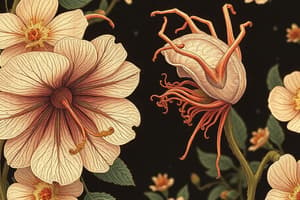Podcast
Questions and Answers
Which type of reproduction involves the process of choosing a mate based on specific traits or characteristics?
Which type of reproduction involves the process of choosing a mate based on specific traits or characteristics?
- Involvement of two distinct types of sex cells
- Asexual reproduction
- Sexual reproduction (correct)
- Production of gametes within the body
What is the key feature of sexual reproduction that leads to a more diverse offspring?
What is the key feature of sexual reproduction that leads to a more diverse offspring?
- Creation of offspring with desirable traits
- Sexual selection
- Production of gametes within the body
- Involvement of two distinct types of sex cells (correct)
In asexual reproduction, how are the offspring produced?
In asexual reproduction, how are the offspring produced?
- From two distinct types of sex cells
- By mating with another individual
- Through the involvement of gametes
- From a single parent (correct)
Which method of reproduction is more common in simple organisms such as bacteria, fungi, and plants?
Which method of reproduction is more common in simple organisms such as bacteria, fungi, and plants?
What is a key feature of asexual reproduction?
What is a key feature of asexual reproduction?
In human reproduction, where does fertilization typically occur?
In human reproduction, where does fertilization typically occur?
The process by which a female's body prepares for a potential pregnancy is known as:
The process by which a female's body prepares for a potential pregnancy is known as:
What happens during embryonic development?
What happens during embryonic development?
Which organ is not part of the female reproductive system?
Which organ is not part of the female reproductive system?
What is responsible for the production, storage, and transport of gametes?
What is responsible for the production, storage, and transport of gametes?
Flashcards are hidden until you start studying
Study Notes
Reproduction: Understanding Sexual and Asexual Methods
Reproduction is the process by which an organism generates offspring, which can continue its species. Organisms reproduce sexually or asexually, with each method having its unique characteristics and advantages. In this article, we will explore the concepts of sexual and asexual reproduction, the reproductive system, human reproduction, and fertilization.
Sexual Reproduction
Sexual reproduction involves the fusion of two distinct types of sex cells, known as gametes, which are sperms in males and eggs in females. These gametes may be produced within the body, as in humans, or externally, as in some insects. The result of this fusion is a zygote, which develops into a new individual.
Key features of sexual reproduction include:
- Greater genetic diversity: The combination of genetic material from two parents leads to a more diverse offspring, increasing the chances of survival in changing environments.
- Sexual selection: The process of choosing a mate based on specific traits or characteristics can lead to the creation of offspring with desirable traits.
Asexual Reproduction
Asexual reproduction, on the other hand, occurs without the involvement of gametes. Instead, a single individual produces offspring from a single parent. This method is more common in simple organisms, such as bacteria, fungi, and plants.
Key features of asexual reproduction include:
- Faster reproduction: Asexual organisms can reproduce more quickly, as they do not need to wait for a mate.
- Greater control over offspring: A single parent can produce offspring with specific characteristics or traits.
Reproductive System
The reproductive system is responsible for the production, storage, and transport of gametes. In humans, the female reproductive system consists of the ovaries, fallopian tubes, uterus, and vagina, while the male reproductive system includes the testes, epididymis, vas deferens, and urethra. The process of human reproduction involves several key stages:
- Fertilization: The sperm travels through the female reproductive tract and fertilizes the egg, which develops into a zygote.
- Embryonic development: The zygote begins to develop into an embryo within the uterus.
- Birth: The embryo grows into a fetus and is born through the vagina.
Human Reproduction
Human reproduction is a complex process that involves the interaction of several hormones and organs. The menstrual cycle is the process by which a female's body prepares for a potential pregnancy. During this cycle, an egg is released from the ovary and travels through the fallopian tube, where it may be fertilized by sperm. If the egg is fertilized, it implants itself in the uterus and begins to develop into a fetus.
Fertilization
Fertilization is the process by which a sperm fertilizes an egg, leading to the formation of a zygote. This process occurs in the fallopian tube, where the sperm and egg meet and fuse. The resulting zygote continues to develop and eventually implants itself in the uterus, where it grows into a fetus.
In conclusion, reproduction is a fundamental aspect of life, allowing organisms to create offspring and continue their species. Both sexual and asexual reproduction have their unique characteristics and benefits, depending on the species and environment. Understanding these processes and the reproductive system is essential in gaining a comprehensive knowledge of biology and life.
Studying That Suits You
Use AI to generate personalized quizzes and flashcards to suit your learning preferences.




